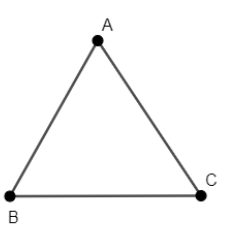
In an acute-angled triangle ABC, if $\sin \left( A+B-C \right)=\dfrac{1}{2}$ and $\cos \left( B+C-A \right)=\dfrac{1}{\sqrt{2}}$, then find the measure of each angle of the triangle.
Answer
591.3k+ views
Hint: Find the acute angle solution of the equations $\sin x=\dfrac{1}{2}$ and $\cos x=\dfrac{1}{\sqrt{2}}$. Write equations based on the data given in the question. Solve those equations to calculate the measure of all the angles.
Complete step-by-step answer:
We know that in an acute-angled triangle ABC, we have $\sin \left( A+B-C \right)=\dfrac{1}{2}$ and $\cos \left( B+C-A \right)=\dfrac{1}{\sqrt{2}}$. We have to calculate the measure of each angle of the triangle.

We will first calculate the acute angle solution of the equations $\sin x=\dfrac{1}{2}$ and $\cos x=\dfrac{1}{\sqrt{2}}$.
We know that $\sin {{30}^{\circ }}=\dfrac{1}{2}$ and $\cos {{45}^{\circ }}=\dfrac{1}{\sqrt{2}}$. We also know that $\sin \left( A+B-C \right)=\dfrac{1}{2}$ and $\cos \left( B+C-A \right)=\dfrac{1}{\sqrt{2}}$.
Thus, we have $A+B-C={{30}^{\circ }}.....\left( 1 \right)$ and $B+C-A={{45}^{\circ }}.....\left( 2 \right)$.
We also know that the sum of all angles of a triangle is ${{180}^{\circ }}$. Thus, we have $A+B+C={{180}^{\circ }}.....\left( 3 \right)$.
We will now simplify all the equations.
Subtracting equation (1) from equation (3), we have $\left( A+B+C \right)-\left( A+B-C \right)={{180}^{\circ }}-{{30}^{\circ }}$.
Thus, we have $2C={{150}^{\circ }}$. Rearranging the terms of the previous equation, we have $C=\dfrac{{{150}^{\circ }}}{2}={{75}^{\circ }}.....\left( 4 \right)$.
Substituting equation (4) in equation (2), we have $B+{{75}^{\circ }}-A={{45}^{\circ }}$. Rearranging the terms of the above equation, we have $B-A={{45}^{\circ }}-{{75}^{\circ }}=-{{30}^{\circ }}.....\left( 5 \right)$.
Similarly, substituting equation (4) in equation (3), we have ${{75}^{\circ }}+B+A={{180}^{\circ }}$. Rearranging the terms of the above equation, we have $A+B={{180}^{\circ }}-{{75}^{\circ }}={{105}^{\circ }}.....\left( 6 \right)$.
We will now simplify equations (5) and (5). Adding equation (5) and (6), we have $B-A+\left( A+B \right)={{105}^{\circ }}-{{30}^{\circ }}$. Thus, we have $2B={{75}^{\circ }}\Rightarrow B=\dfrac{{{75}^{\circ }}}{2}={{37.5}^{\circ }}$.
Substituting $B={{37.5}^{\circ }}$ in equation (6), we have $A+{{37.5}^{\circ }}={{105}^{\circ }}$. Thus, we have $A={{105}^{\circ }}-{{37.5}^{\circ }}={{67.5}^{\circ }}$.
Hence, the measure of all the angles of the triangle is $\angle A={{67.5}^{\circ }},\angle B={{37.5}^{\circ }},\angle C={{75}^{\circ }}$.
Note: We can’t solve this question without using the fact that the sum of all interior angles of a triangle is ${{180}^{\circ }}$. If we don’t use this fact, we will get an incorrect measure of the angles of the triangle. We must write the measures of all the angles in degrees or radians.
Complete step-by-step answer:
We know that in an acute-angled triangle ABC, we have $\sin \left( A+B-C \right)=\dfrac{1}{2}$ and $\cos \left( B+C-A \right)=\dfrac{1}{\sqrt{2}}$. We have to calculate the measure of each angle of the triangle.

We will first calculate the acute angle solution of the equations $\sin x=\dfrac{1}{2}$ and $\cos x=\dfrac{1}{\sqrt{2}}$.
We know that $\sin {{30}^{\circ }}=\dfrac{1}{2}$ and $\cos {{45}^{\circ }}=\dfrac{1}{\sqrt{2}}$. We also know that $\sin \left( A+B-C \right)=\dfrac{1}{2}$ and $\cos \left( B+C-A \right)=\dfrac{1}{\sqrt{2}}$.
Thus, we have $A+B-C={{30}^{\circ }}.....\left( 1 \right)$ and $B+C-A={{45}^{\circ }}.....\left( 2 \right)$.
We also know that the sum of all angles of a triangle is ${{180}^{\circ }}$. Thus, we have $A+B+C={{180}^{\circ }}.....\left( 3 \right)$.
We will now simplify all the equations.
Subtracting equation (1) from equation (3), we have $\left( A+B+C \right)-\left( A+B-C \right)={{180}^{\circ }}-{{30}^{\circ }}$.
Thus, we have $2C={{150}^{\circ }}$. Rearranging the terms of the previous equation, we have $C=\dfrac{{{150}^{\circ }}}{2}={{75}^{\circ }}.....\left( 4 \right)$.
Substituting equation (4) in equation (2), we have $B+{{75}^{\circ }}-A={{45}^{\circ }}$. Rearranging the terms of the above equation, we have $B-A={{45}^{\circ }}-{{75}^{\circ }}=-{{30}^{\circ }}.....\left( 5 \right)$.
Similarly, substituting equation (4) in equation (3), we have ${{75}^{\circ }}+B+A={{180}^{\circ }}$. Rearranging the terms of the above equation, we have $A+B={{180}^{\circ }}-{{75}^{\circ }}={{105}^{\circ }}.....\left( 6 \right)$.
We will now simplify equations (5) and (5). Adding equation (5) and (6), we have $B-A+\left( A+B \right)={{105}^{\circ }}-{{30}^{\circ }}$. Thus, we have $2B={{75}^{\circ }}\Rightarrow B=\dfrac{{{75}^{\circ }}}{2}={{37.5}^{\circ }}$.
Substituting $B={{37.5}^{\circ }}$ in equation (6), we have $A+{{37.5}^{\circ }}={{105}^{\circ }}$. Thus, we have $A={{105}^{\circ }}-{{37.5}^{\circ }}={{67.5}^{\circ }}$.
Hence, the measure of all the angles of the triangle is $\angle A={{67.5}^{\circ }},\angle B={{37.5}^{\circ }},\angle C={{75}^{\circ }}$.
Note: We can’t solve this question without using the fact that the sum of all interior angles of a triangle is ${{180}^{\circ }}$. If we don’t use this fact, we will get an incorrect measure of the angles of the triangle. We must write the measures of all the angles in degrees or radians.
Recently Updated Pages
Why are manures considered better than fertilizers class 11 biology CBSE

Find the coordinates of the midpoint of the line segment class 11 maths CBSE

Distinguish between static friction limiting friction class 11 physics CBSE

The Chairman of the constituent Assembly was A Jawaharlal class 11 social science CBSE

The first National Commission on Labour NCL submitted class 11 social science CBSE

Number of all subshell of n + l 7 is A 4 B 5 C 6 D class 11 chemistry CBSE

Trending doubts
What is meant by exothermic and endothermic reactions class 11 chemistry CBSE

10 examples of friction in our daily life

One Metric ton is equal to kg A 10000 B 1000 C 100 class 11 physics CBSE

1 Quintal is equal to a 110 kg b 10 kg c 100kg d 1000 class 11 physics CBSE

Difference Between Prokaryotic Cells and Eukaryotic Cells

What are Quantum numbers Explain the quantum number class 11 chemistry CBSE




